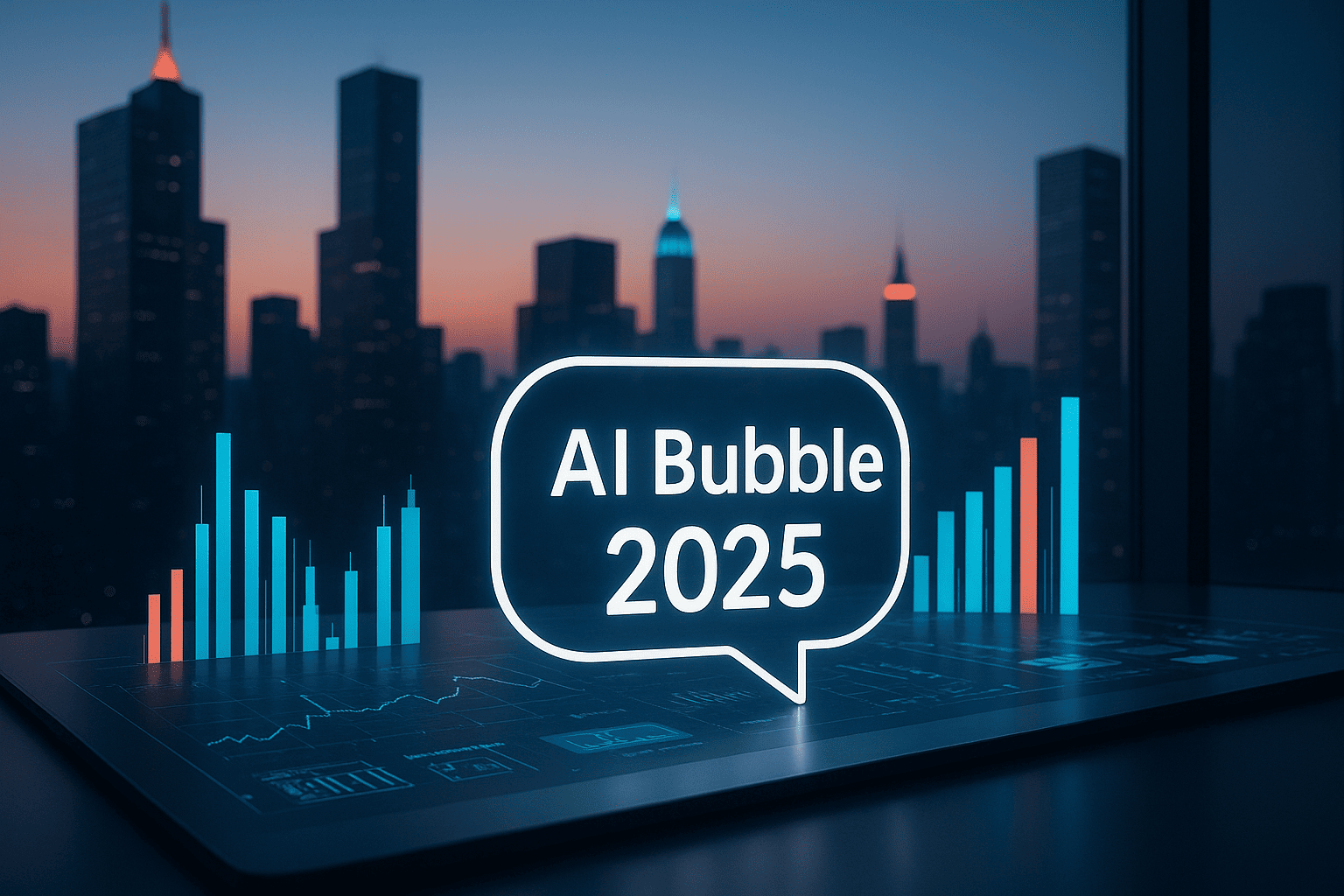Introduction:Is the AI Bubble Starting to Burst? Navigating Risks & Opportunities in 2025
The buzz around artificial intelligence has dominated headlines, stock markets, and boardrooms over the past two years. Companies tied to AI—from chipmakers to cloud giants—have seen explosive growth in valuations. But with rapid expansion often comes speculation: is the AI bubble 2025 already forming, and if so, how should investors navigate the risks while still capturing opportunities?
In this article, we’ll unpack what’s fueling AI valuations, examine bubble signals versus sustainable growth, and outline practical portfolio strategies for readers in the USA, UK, and Canada.
What’s Driving AI Valuations in 2025
AI Bubble 2025-Earnings, Hype Cycles & Liquidity
Much of the current AI boom reflects genuine innovation. Demand for large language models, autonomous systems, and enterprise automation is real. Yet, hype cycles amplify expectations. We saw a similar dynamic during the dot-com era: vast sums of capital poured in, not always tied to profits.
Liquidity also matters. With interest rates stabilizing in early 2025, investors are again chasing growth. That fuels higher multiples for AI firms, especially in stocks like Nvidia, Microsoft, and Alphabet. However, stretched valuations can turn fragile if earnings disappoint.
Where Fundamentals Still Look Strong in AI Bubble 2025
Despite concerns, some fundamentals remain solid. AI-driven semiconductor demand continues to grow as data centers expand capacity. Cloud adoption of AI services is accelerating across industries, from finance to healthcare. Companies with strong cash flow, proven moats, and diverse revenue—such as Microsoft AI and Alphabet AI—may justify premium valuations.

Signs of a AI Bubble 2025 vs Healthy Growth
AI Bubble 2025 Red Flags to Watch (FOMO, P/S, Concentration)
The AI bubble 2025 debate often centers on valuation metrics. Price-to-sales (P/S) ratios for leading AI stocks have reached double digits, similar to levels seen in past bubbles. Another warning sign is concentration risk: a handful of mega-cap names dominate AI indices, leaving investors exposed if sentiment shifts.

FOMO—fear of missing out—has also taken hold. Retail traders pile into AI stocks without considering fundamentals, a hallmark of speculative bubbles. If too much capital chases too few names, corrections can be sharp.
Green Flags in AI Bubble 2025: Cash Flow, Moats, Adoption
Not all is froth. Healthy signs include consistent free cash flow growth, strong balance sheets, and competitive moats. Companies securing long-term AI adoption contracts—like enterprise cloud deals—show real-world demand. Unlike some past tech fads, AI has deep utility across industries, suggesting that even if a bubble forms, lasting value will remain.

Risks for Investors in AI Bubble 2025
Market Volatility & Macro Headwinds in AI Bubble 2025
Even strong businesses can suffer if markets turn volatile. Global uncertainty—ranging from elections to interest rate surprises—creates risk for all equities, including AI. Valuations are sensitive: if interest rates rise again, growth multiples could compress. Market volatility in 2025 may trigger corrections across tech, regardless of fundamentals.
Regulatory & Competitive Pressure Affecting AI Bubble in 2025
Another risk comes from regulation. Governments in the USA, UK, and EU are considering stricter rules on AI deployment, data privacy, and ethical use. Added compliance costs could pressure margins. At the same time, competition is fierce. Dozens of start-ups are challenging incumbents, eroding pricing power.
Opportunities If the AI Bubble 2025 Deflates
Dollar-Cost Averaging & Valuation Discipline
If the bubble narrative plays out, that doesn’t mean investors should abandon AI. Instead, disciplined strategies like dollar-cost averaging (DCA) allow investors to buy shares gradually, smoothing entry points. Waiting for corrections before adding exposure can also help capture better valuations without trying to time the market perfectly.
Diversification: AI ETFs & Defensive Sectors
Another smart play is diversification. Investors who want AI exposure without betting on a single stock might explore options like the best AI ETFs for 2025, which spread risk across multiple companies. Pairing AI with defensive sectors such as healthcare, utilities, or consumer staples can balance risk.
Beyond stock valuations, investors are also exploring tools like AI robo-advisors, which are changing how portfolios are managed and could play a role if the AI bubble 2025 begins to shift.”
Portfolio Strategies for USA, UK & Canada
Conservative, Balanced, and Growth Mixes
For conservative investors, a smaller allocation to AI (5–10%) alongside bonds or dividend stocks may be appropriate. Balanced portfolios might allocate 15–20% toward AI, combined with global equities and defensive sectors. Growth-oriented investors may tilt higher, but even then, diversification remains crucial.
In the USA, exposure can come via Nasdaq-listed AI ETFs. UK investors might consider London-listed funds, while Canadians have options on the TSX. Regional availability differs, but the principle remains the same: tailor exposure to your goals and risk tolerance.
FAQs
Is the AI bubble 2025 real?
It’s too early to say definitively. Some signs suggest froth, like extreme valuations, while other signals—such as strong adoption and real cash flow—show durability.
Should beginners wait or invest now?
Beginners may prefer starting small with diversified ETFs or steady DCA strategies. That way, they avoid overexposure if volatility spikes.
What’s safer—AI ETFs or single stocks?
ETFs generally offer lower risk by spreading exposure, while single stocks can deliver higher returns but also higher losses. Risk tolerance should guide the choice.
Conclusion & Next Steps
The question isn’t whether AI is valuable—it clearly is—but whether markets have priced it too aggressively in 2025. Investors should watch valuation metrics closely, stay diversified, and apply long-term discipline.
For those in the USA, UK, and Canada, the key lies in balancing opportunity with caution. AI is transformative, but no trend is immune to cycles. A thoughtful approach ensures investors can capture growth while limiting downside.
Educational purposes only, not financial advice.

1 thought on “Is the AI Bubble Starting to Burst? Navigating Risks & Opportunities in 2025”